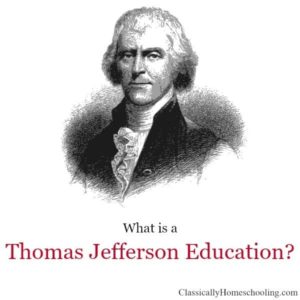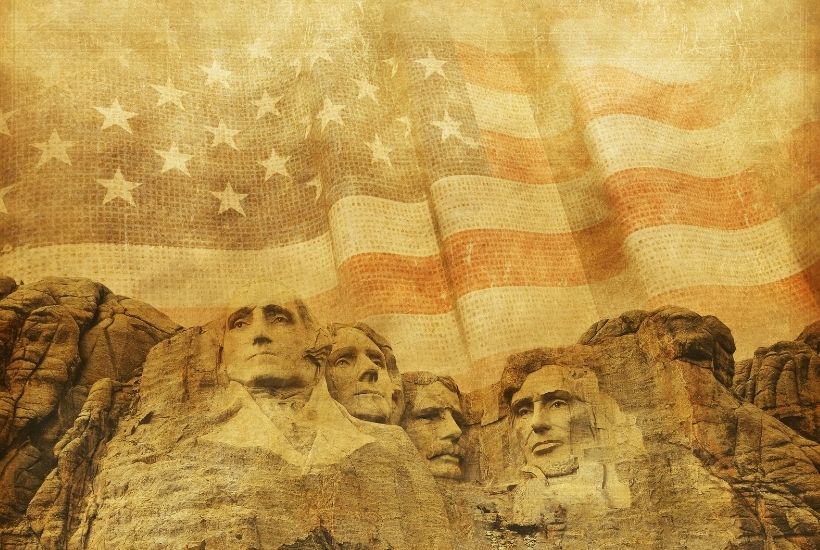Thomas Jefferson Education: A Leadership Education
This post may contain affiliate links. For more information, please read my disclosure policy.
A Thomas Jefferson Education: A Leadership Education
A Thomas Jefferson Education by Oliver Van Demille does not denote a modern classical education in the manner Dorothy Sayers spoke of in The Lost Tools of Learning.
Rather, it is an education that reflects the old style the American Founding Fathers received.
Oliver Van Demille in A Thomas Jefferson Education speaks of three types of education that show up through history and in modern American society.
The first is the Conveyer Belt Education. This a factory style of education. The goal is for everyone to receive the exact same schooling as everyone else. Schooling prepares people for their place in society.
Professional Education is the second style mentioned. This style includes apprenticeships, trade schools, and engineering or medical programs. The goal is to produce specialists.
Leadership Education is the last type of education referred to in A Thomas Jefferson Education. It is a style designed to teach students how to think, learn, and be leaders in their homes and communities.
Unlike the modern classical education movement, A Thomas Jefferson Education has four phases rather than three.
Core Phase (0-8 years)
During the core phase learning morals is the goal. Children must learn right from wrong at an instinctive level. We don’t need future leaders wondering if it’s right to steal or pondering the merits of murdering opponents.
The core phase is used to instill a strong sense of morality in our young children.
Schooling is relaxed during these years with an emphasis on providing a rich environment. We are encouraged to have our small children spend time reading books with us, exploring the community, and playing.
Love of Learning Phase (8-12 years)
The love of learning phase is accompanied by exposure to many areas of knowledge while schooling is increased gradually.
The child uses the foundation laid in the core phase to build expertise in personal gifts, love of the community, and knowledge of self. Exploration is encouraged.
Both the core phase and the love of learning phase correspond roughly to classical education’s grammar stage, when we’re teaching our young ones reading, writing, and arithmetic. It’s a time of exposure to the world.
Scholar Phase (12-16 years)
This loosely corresponds, somewhat, with the classical education’s logic stage. This period is marked by the onset of puberty and a new readiness for accountability. The student is exposed to classic works, discussions, and the great ideas of humanity.
A Thomas Jefferson Education speaks also of giving scholar phase children both privileges and areas of responsibilities to mature our young leaders, as well as giving them long hours of study.
The study during this age should cover topics with passion and enthusiasm. The goal is to inspire our children to future study rather than subjecting them to unrelenting requirements.
 Depth Phase (16-22 years)
Depth Phase (16-22 years)
The depth phase is roughly the same as the rhetoric stage in classical education. The students prepare for the responsibilities of adulthood. They read and discuss classics with mentors.
Opportunities for exposure to conflicting ideas and conflicts are ideal. These young adults thrive in the college setting where they can follow their passions under the guidance of a mentor.
A Thomas Jefferson Education is not the exact same as modern classical education, but it is parallel. Both systems use classics and discussions as the primary method of teaching older children with the goal of having children able to think, lead, and join the Great Conversation.









I had major problems with this book. The idea sounds wonderful, but if you look back at the actual life of Thomas Jefferson, he was not taught in the same manner this book (and the others in the series) suggests. It is not so apparent in the first book, as it is mainly a philosophy of sorts. But if you read the second book, which gets into the particulars of their educational method, you will find it is more of an unschooling method.
Thomas Jefferson and other leaders in our history were taught in a more classical way. They learned their facts, names, dates, etc. in the grammar stage. They did have mentors and they participated in apprenticeships, but not until their formal “book learning” was well established.
I’ve never read the second book, so I can’t speak at all to the particulars of their educational method.
It’s fun to think about how Thomas Jefferson and his peers would have been education. At the time there was no formal grammar, logic, or rhetoric stages. Although he would likely have started with light lessons in Latin, Greek, and English as a young child. Which does mean memorizing Latin and Greek vocabulary and grammar. Sometime around puberty, he’d spend quite a bit of time studying the classical (in the original Latin or Greek). I’m trying to remember if he went on to university. Do you know, Cindy?
I’ll admit. I much prefer The Well-Trained Mind’s approach to education! 🙂